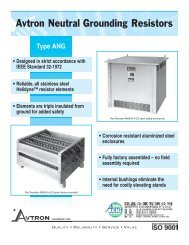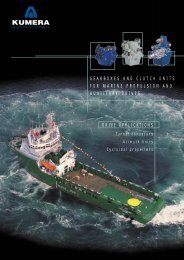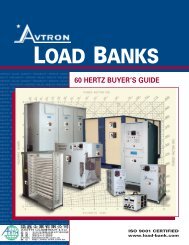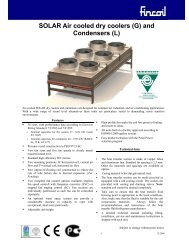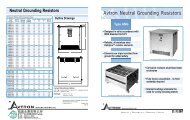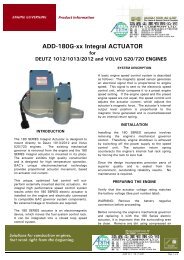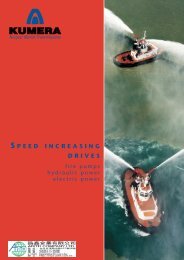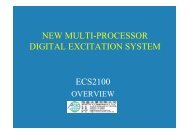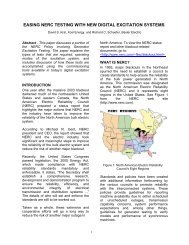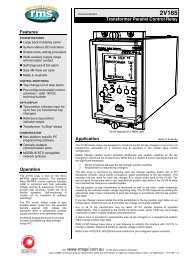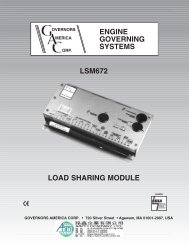Primary winding current transformer, type WSK
Primary winding current transformer, type WSK
Primary winding current transformer, type WSK
Create successful ePaper yourself
Turn your PDF publications into a flip-book with our unique Google optimized e-Paper software.
Low voltage <strong>current</strong> <strong>transformer</strong>s for industrial applications<strong>Primary</strong> <strong>winding</strong> <strong>current</strong> <strong>transformer</strong><strong>WSK</strong> 30 – page 5 Transformer width 61mm<strong>WSK</strong> 40 – page 6 Transformer width 71mm<strong>WSK</strong> 40 N – page 7 Transformer width 71mm<strong>WSK</strong> 60 – page 8 Transformer width 71mm<strong>WSK</strong> 70.6 – page 9 Transformer width 60mm<strong>WSK</strong> 70.6 N – page 10 Transformer width 60mm<strong>WSK</strong> 31.5 – page 11 Transformer width 70mmwww.deif.com
Accessories for low voltage <strong>current</strong> <strong>transformer</strong>sSnap-on mountings – page 12Copper tubes – page 12Mounting angle – page 12Mounting kit – page 13Secondary cap – page 13Locking pistons – page 13Sealed shutters – page 13Copper bus bars – page 13www.deif.com
<strong>Primary</strong> <strong>winding</strong> <strong>current</strong> <strong>transformer</strong>Based on the physical operating principle of <strong>current</strong> <strong>transformer</strong>s, the required core volume transferring an amount of power, increases rapidly with adecreasing nominal <strong>current</strong>. As there are limits on increasing the <strong>transformer</strong> size, <strong>Primary</strong> <strong>winding</strong> <strong>current</strong> <strong>transformer</strong> are being used.Interim <strong>current</strong> <strong>transformer</strong>s also belong to the group of <strong>Primary</strong> <strong>winding</strong> <strong>current</strong> <strong>transformer</strong>. This construction is mainly used for primary <strong>current</strong>s ofup to 10A, and achieves a transformation at a higher or lower secondary <strong>current</strong> values. In addition to their application in adapting a measuring circuiton existing measuring units, interim <strong>current</strong> <strong>transformer</strong>s are being used also for lowering the power loss by the transmission of analogically measuredvalues over great distances. This is made possible by means of a squared dependence of the power loss from the flowing <strong>current</strong>.PV = I 2 × Z[VA]apparent power [VA]This means when the original nominal <strong>current</strong> is halved, the conductor loss drops down to 25% of its original value.Indication: The selection of the nominal power of the initially activated main <strong>transformer</strong> is achieved through the application of the followingmeasurement comparisions.2IP GH= P Z× (2)I 1+ P E+ P HZP GHP ZP EP HZI 1I 2apparent power of the main <strong>transformer</strong>secondary performance of the interim <strong>transformer</strong> (nominal performance inclusive of conductor losses)consumption of the interim <strong>transformer</strong> by nominal <strong>current</strong>conductor losses between main- and interim <strong>transformer</strong> by nominal <strong>current</strong>primary nominal <strong>current</strong> of the interim <strong>transformer</strong>secondary nominal <strong>current</strong> of the interim <strong>transformer</strong>www.deif.com
<strong>Primary</strong> <strong>winding</strong> <strong>current</strong> <strong>transformer</strong> <strong>WSK</strong> 30Secondary <strong>current</strong> 5A 1A<strong>Primary</strong><strong>current</strong>A12.55101520Accuracy class Accuracy classBurden 1 0.5 1 0.5VA Art.-no. Art.-no. Art.-no. Art.-no.2.5 3 3 3 35 3 32.5 3 3 3 35 3 32.5 3 3 3 35 3 32.5 3 3 3 35 3 32.5 3 3 3 35 3 32.5 3 3 3 35 3 3<strong>Primary</strong> conductorRound conductorTransformer widthSnap-on mountingSealed shutter61mmAvailableSee “Accessories”AvailableSee “Accessories”www.deif.com
<strong>Primary</strong> <strong>winding</strong> <strong>current</strong> <strong>transformer</strong> <strong>WSK</strong> 40Secondary <strong>current</strong> 5A 1A<strong>Primary</strong><strong>current</strong>A12.551015202530Accuracy class Accuracy classBurden 1 0.5 1 0.5VA Art.-no. Art.-no. Art.-no. Art.-no.2.5 3 3 3 35 3 3 3 310 3 3 3 315 3 3 3 32.5 3 3 3 35 3 3 3 310 3 3 3 315 3 3 3 32.5 3 3 3 35 3 3 3 310 3 3 3 315 3 3 3 32.5 3 3 3 35 3 3 3 310 3 3 3 315 3 3 3 32.5 3 3 3 35 3 3 3 310 3 3 3 315 3 3 3 32.5 3 3 3 35 3 3 3 310 3 3 3 315 3 3 3 32.5 3 3 3 35 3 3 3 310 3 3 3 315 3 3 3 32.5 3 3 3 35 3 3 3 310 3 3 3 3<strong>Primary</strong> conductorRound conductorTransformer widthSnap-on mountingSealed shutter71mmAvailableSee “Accessories”AvailableSee “Accessories”www.deif.com
<strong>Primary</strong> <strong>winding</strong> <strong>current</strong> <strong>transformer</strong><strong>WSK</strong> 40 NSecondary <strong>current</strong> 5A 1A<strong>Primary</strong><strong>current</strong>A304050Accuracy class Accuracy classBurden 1 0.5 1 0.5VA Art.-no. Art.-no. Art.-no. Art.-no.2.5 3 3 3 35 3 3 3 310 3 3 3 32.5 3 3 3 35 3 3 3 310 3 3 3 32.5 3 3 3 35 3 3 3 310 3 3 3 3<strong>Primary</strong> conductorRound conductorTransformer widthSnap-on mountingSealed shutter71mmAvailableSee “Accessories”AvailableSee “Accessories”www.deif.com
<strong>Primary</strong> <strong>winding</strong> <strong>current</strong> <strong>transformer</strong><strong>WSK</strong> 60Secondary <strong>current</strong> 5A 1A<strong>Primary</strong><strong>current</strong>A51015202530Accuracy class Accuracy classBurden 1 0.5 1 0.5VA Art.-no. Art.-no. Art.-no. Art.-no.2.5 3 3 3 35 3 3 3 310 3 3 3 315 3 32.5 3 3 3 35 3 3 3 310 3 3 3 315 3 32.5 3 3 3 35 3 3 3 310 3 3 3 315 3 32.5 3 3 3 35 3 3 3 310 3 3 3 315 3 32.5 3 3 3 35 3 3 3 310 3 3 3 315 3 32.5 3 3 3 35 3 3 3 310 3 3 3 315 3 3PRIMARY<strong>Primary</strong> conductorRound conductorTransformer widthSnap-on mountingSealed shutter71mmAvailableSee “Accessories”www.deif.com
<strong>Primary</strong> <strong>winding</strong> <strong>current</strong> <strong>transformer</strong><strong>WSK</strong> 70.6Secondary <strong>current</strong> 5A 1A<strong>Primary</strong><strong>current</strong>A25304050607580100Accuracy class Accuracy classBurden 1 0.5 1 0.5VA Art.-no. Art.-no. Art.-no. Art.-no.2.5 3 3 3 35 3 3 3 310 3 3 3 315 3 32.5 3 3 3 35 3 3 3 310 3 3 3 315 3 32.5 3 3 3 35 3 3 3 310 3 3 3 315 3 32.5 3 3 3 35 3 3 3 310 3 3 3 315 3 32.5 3 3 3 35 3 3 3 310 3 3 3 315 3 32.5 3 3 3 35 3 3 3 310 3 3 3 315 3 32.5 3 3 3 35 3 3 3 310 3 3 3 315 3 32.5 3 3 3 35 3 3 3 310 3 3 3 315 3 3<strong>Primary</strong> conductorRound conductorTransformer widthSnap-on mountingSealed shutter60mmAvailableSee “Accessories”www.deif.com
<strong>Primary</strong> <strong>winding</strong> <strong>current</strong> <strong>transformer</strong><strong>WSK</strong> 70.6 NSecondary <strong>current</strong> 5A 1A<strong>Primary</strong><strong>current</strong>A25304050607580100Accuracy class Accuracy classBurden 1 0.5 1 0.5VA Art.-no. Art.-no. Art.-no. Art.-no.2.5 3 3 3 35 3 3 3 310 3 3 3 315 3 32.5 3 3 3 35 3 3 3 310 3 3 3 315 3 32.5 3 3 3 35 3 3 3 310 3 3 3 315 3 32.5 3 3 3 35 3 3 3 310 3 3 3 315 3 32.5 3 3 3 35 3 3 3 310 3 3 3 315 3 32.5 3 3 3 35 3 3 3 310 3 3 3 315 3 32.5 3 3 3 35 3 3 3 310 3 3 3 315 3 32.5 3 3 3 35 3 3 3 310 3 3 3 315 3 3<strong>Primary</strong> conductorRound conductorTransformer widthSnap-on mountingSealed shutter60mmAvailableSee “Accessories”10 www.deif.com
<strong>Primary</strong> <strong>winding</strong> <strong>current</strong> <strong>transformer</strong><strong>WSK</strong> 31.5Secondary <strong>current</strong> 5A 1A<strong>Primary</strong><strong>current</strong>A25304050607580100150Accuracy class Accuracy classBurden 1 0.5 1 0.5VA Art.-no. Art.-no. Art.-no. Art.-no.2.5 3 3 3 35 3 3 3 310 3 3 3 315 3 3 3 32.5 3 3 3 35 3 3 3 310 3 3 3 315 3 3 3 32.5 3 3 3 35 3 3 3 310 3 3 3 315 3 3 3 32.5 3 3 3 35 3 3 3 310 3 3 3 315 3 3 3 32.5 3 3 3 35 3 3 3 310 3 3 3 315 3 3 3 32.5 3 3 3 35 3 3 3 310 3 3 3 315 3 3 3 32.5 3 3 3 35 3 3 3 310 3 3 3 315 3 3 3 32.5 3 3 3 35 3 3 3 310 3 3 3 315 3 3 3 32.5 3 3 3 35 3 3 3 310 3 3 3 315 3 3 3 3<strong>Primary</strong> conductorRound conductorTransformer widthSnap-on mountingSealed shutterCurrent <strong>transformer</strong> fortariff applications70mmAvailableSee “Accessories”See “Accessories”www.deif.com 11
Snap-on mountingsSnap-on mounting fortube-, plug-in, protection- and tariff <strong>transformer</strong>sFor use with DEIF <strong>current</strong> <strong>transformer</strong>sArt.-no.ASR 22.3; ASK 21.3, 31.3, 318.3, 41.3, ; <strong>WSK</strong> 30, SASR 22.3, EASR 22.3, 21.3, EASK 31.3 3ASK 31.4, 31.4 2U/3U, EASK 31.4 3ASK 31.5, 31.5 2U, <strong>WSK</strong> 40 N, SASK 31.5, EASK 31.5, 31.5 2U 3ASK 41.4, 412.4, 41.4 2U/3U, 412.4 2U/3U <strong>WSK</strong> 40, SASK 41.4, EASK 41.4, 41.4 2U 3ASR 14.3, 20.3, 201.3 3ASR 21.3, ASK 205.3, SASK 21.3 3Copper tubesCopper tubeLength Outside Ø Inner Ø Max. <strong>current</strong> Art.-no.34 22.5 16.5 600A 336 22.5 16.5 600A 3different lengths available upon request34 22.5 12.5 600A 336 22.5 12.5 600A 3different lengths available upon request34 22.5 8.5 600A 336 22.5 8.5 600A 3different lengths available upon request32 21 12.5 600A 334 21 12.5 600A 3different lengths available upon request32 21 8.5 600A 334 21 8.5 600A 3different lengths available upon requestMounting angle for 3-phase <strong>current</strong> <strong>transformer</strong> setMounting angle for triple set (2 pcs) plug-in, protection- and tariff <strong>transformer</strong>sFor use with DEIF <strong>current</strong> <strong>transformer</strong>sArt.-no.ASK 421.4; 41.4; 412.4; <strong>WSK</strong> 40; <strong>WSK</strong> 40 N 3ASK 41.5 312 www.deif.com
Mounting kitMounting kitScrew M 12 × 40Art.-no.with voltage taps M5 3with voltage taps M5 and locking piston bus bar 30mm 3with voltage taps M5 and locking piston bus bar 40mm 3with voltage taps M5 and locking piston bus bar 50mm 3standard 3standard with locking piston bus bar 30mm 3standard with locking piston bus bar 40mm 3standard with locking piston bus bar 50mm 3Secondary capSecondary capArt.-no.3Locking pistonsDimensions [mm]Art.-no.copper bus bar 30 × 6 30 × 8 30 × 10 3copper bus bar 40 × 6 40 × 8 40 × 10 3copper bus bar 50 × 6 50 × 8 50 × 10 3Sealed shuttersSealed shutter for tube-, plug-in, protection- and tariff <strong>current</strong> <strong>transformer</strong>sFor use with DEIF <strong>current</strong> <strong>transformer</strong>sArt.-no.ASR 22.3; ASK 21.3; 31.3; 318.3; 41.3; 103.3(2x); 123.3(2x); <strong>WSK</strong> 30, SASK 22.3, 21.3,EASR22.3, 21.3, EASK 31.3, 123.3(2x)3ASK 31.4; 31.4 2U/3U, 31.5; 31.5 2U, 421.4; 41.4; 41.4 2U/3U, 412.4; 412.4 2U/3U, <strong>WSK</strong>40, 40 N, 60, 70.6 N, KSU 2…3, SUSK 3..8 primär, SASK 31.5, 421.4, 41.4, EASK 31.4,31.5, 331.5 2U, 41.4, 41.4 2U, ESUSK 2…8 primär.ASK 541.4; 51.4,51.4 2U/3U, 561.4; 61.4, 61.4 2U/3U, 63.4; 63.6, 81.4, 81.4 2U/3U, 101.4, 1012U/3U, 105.6; 105.6N; 127.4; 127.6; 128.4; 129.10, SUSK 3..8 sekundär, SASK 541.4, 51.4, 61.4, 363.6, 105.6, EASK 541.4, 51.4, 51.4 2U, 61.4, 63.6, 81.4, 105.6, ESUSK 2...8 sekundär<strong>WSK</strong> 70.6 3ASK 31.6; 41.6; 51.6; 61.6, SASK 31.6, 41.6, 51.6, EASK 31.6, 41.6, 51.6, 61.6 3<strong>WSK</strong> 31.5, E<strong>WSK</strong> 31.5 3www.deif.com 13
Current <strong>transformer</strong>sTechnical characteristicsCurrent <strong>transformer</strong>s are special <strong>transformer</strong>s for the proportional transformation of high <strong>current</strong>s into directly measurable values. Their constructionand physical operating principle enables a galvanic separation of the primary circuit from the measured circuit, thereby providing a protection forsequentially connected instruments in the event of a fault.Rated limit <strong>current</strong>[I PL]Rated <strong>current</strong> intensity[I N]Rated powervalue of the lowest primary <strong>current</strong> where, by the secondary measuring burden, the total deviation of the<strong>current</strong> <strong>transformer</strong> for measuring purposes is equal to or greater than 10%.is the noted specified value of the primary and secondary <strong>current</strong> on the rating plate.Standardized primary nominal <strong>current</strong>s have the following values: 5A, 10A, 15A, 20A, 25A,30A, 40A, 50A, 60A, 75A, 100A with a decadic multiple of the previously mentioned value to a max. of7500A. Standardized secondary nominal <strong>current</strong>s have the values 5A and 1A.the value of the apparent power (in a VA specified power factor), which the <strong>current</strong> <strong>transformer</strong> is intended tosupply to the secondary circuit and rated burden at the rated secondary <strong>current</strong>.Earthing ofsecondary terminalsPhase displacement error[δ]Accuracy classTotal measuring deviation(Current error)according to VDE 0141, section 5.3.4., <strong>current</strong>- and voltage <strong>transformer</strong>s have to be earthed, starting from U m= 3.6kV. With low voltage (up to U m– 1.2kV) no earthing is required, as long as the <strong>transformer</strong> housings haveno visible exposed metal surfaces.signifies the phase shift of the primary <strong>current</strong> and the secondary <strong>current</strong>. The direction of the indicator isarranged in such a way, that with an optimum produced <strong>current</strong> <strong>transformer</strong> the phase displacement error isequal to zero (IEV 321-01-23 modified).The phase displacement error is to be regarded as positive when the indicator of the secondary <strong>current</strong> isahead compared to the indicator of the primary <strong>current</strong>. The phase displacement error is specified in minutesor hundredths of a radiant. Note: Strictly speaking this definition is only valid for sinus <strong>type</strong> <strong>current</strong>s.the denotation for a <strong>current</strong> <strong>transformer</strong> whose measuring deviation remains below the prescribed operatingcondition.is the effective value in stationary position, and the difference between:a) the momentary value of the primary <strong>current</strong> andb) the momentary value of the measuring transmission of the multiplied actual secondary <strong>current</strong>, wherebythe positive indicators of the primary and secondary <strong>current</strong> correspond to the accord for the connectiondenotation. The total deviation F1 is generally rendered in the percentages of the effective value of theprimary <strong>current</strong>, as per the following mathematical equation.F I= total measuring deviation in %i P= momentary value of the primary <strong>current</strong>K N= rated measuring transmissioni S= momentary value of the secondary <strong>current</strong>I P= effective value of the primary <strong>current</strong>T = duration of periodFI =100lp1√ T∫ OT(K Ni S– i P) 2 dtMax. voltage for electricalequipment U mBurdenRated burdenRated surge <strong>current</strong>[I DYN]Actual transformation rationthis denotes the highest constant permitted value for phase to phase voltage for which the <strong>current</strong><strong>transformer</strong>s isolation is rated.the impedance of the secondary <strong>current</strong> is declared in ohms and power factor. The burdenis usually expressed as the apparent power in voltamperes, absorbed at a specified power-factor and at therated secondary <strong>current</strong>.the value of the burden upon which the accurate requirements of this specifications are based.peak value of the primary <strong>current</strong>, whose electro-mechanical impact is resisted by the <strong>current</strong> <strong>transformer</strong> withshort circuited secondary <strong>winding</strong>. The value of the nominal search <strong>current</strong> IDYN has to be 2.5 × I TH. Onlywhen there is a deviation from this value, the rating plate has to state I DYN.is the ratio of the primary nominal <strong>current</strong> to the secondary <strong>current</strong>. It is specified as an unabridged break onthe rating plate.14 www.deif.com
Current <strong>transformer</strong>sTechnical characteristicsOpen circuit voltage of <strong>current</strong><strong>transformer</strong>sBus bar cross sectionCurrent <strong>transformer</strong>s, which are not directly encumbered with a burden, are generally secondarily shortcircuited. A secondary open <strong>current</strong> <strong>transformer</strong> operates like a loaded one with an almost infinitely highburden. The curve shape of the secondary <strong>current</strong> is extremely deformed and under certain conditions voltagesurges occur which can be harmful to human beings. The amount of the induced “loss motion” depends onthe core cross-section and the number of secondary turns. For DEIF <strong>current</strong> <strong>transformer</strong>s of lower ratings andwith a nominal transmission ratio up to 500/5, the peak value of this voltage is Û ≤ 200 V. For reasons ofhazard protection and to prevent magnetization of the iron core, an open secondary circuit is to be avoided.The openings of our individual plug-in <strong>transformer</strong>s for the acceptance of primary bus bars or their crosssections– even when supplied with copper bus bars – are not decisive for the dimensioning of the bus barunits. The cross section of the bus bar is permitted to be smaller over a short distance in the <strong>transformer</strong> area,provided the adjacent bus bar cross sections are dimensioned in such a manner that any possible excess heatcan easily be absorbed.Special configurationsSaturation <strong>transformer</strong>sTropicalized versions<strong>Primary</strong> nominal <strong>current</strong>s deviating from the standard seriesSecondary change-over unitsDeviating frequency (16 2 / 3Hz up to 400Hz)Resin hardened for extreme mechanical demands (shakeproof)upon requestupon requestupon requestrefer to the relevant <strong>type</strong>s of ct’supon requestupon requestCurrent erroris the percentage deviation of the nominal transmission multiplied by the secondary <strong>current</strong> from that of theprimary <strong>current</strong>. The <strong>current</strong> error is calculated positively, should the actual value of the secondary <strong>current</strong>exceed the nominal value.F II SI PK N= <strong>current</strong> error in %= secondary <strong>current</strong> in A (effective value)= primary <strong>current</strong> in A (effective value)= rated measuring ratioF I= 100%I SK N– I PI PThermal nominal continuousrated <strong>current</strong>[I D]is the primary <strong>current</strong> which allows the continuous operation of the <strong>current</strong> <strong>transformer</strong>. When using this<strong>current</strong> value, the temperature of the secondary wiring must not exceed the prescribed values mentioned inthe actual technical norms. These values are in direct relation to the isolation material class. Should a thermalrated <strong>current</strong> be defined which is larger than the primary rated <strong>current</strong>, the preference values of 120%, 150%and 200% should reflect those of the primary rated <strong>current</strong>.Thermal rated short-time <strong>current</strong>[I TH]Over-<strong>current</strong> rated limiting factor(FS)This value indicates the effective value of the primary <strong>current</strong> which the <strong>current</strong> <strong>transformer</strong>s can withstandwith short circuited secondary <strong>winding</strong>.Other rated measuring values as 1s, e.g. 0.5s, 2s and 3s are acceptable. The thermal short time rated <strong>current</strong>Ith has to be stated for each <strong>current</strong> <strong>transformer</strong>.is the ratio of the limit rated <strong>current</strong> to the primary rated <strong>current</strong>.Note 1: It ought to be noted that the actual over-load rated <strong>current</strong> is influenced by the burden.Note 2: Should the primary <strong>winding</strong> of the <strong>current</strong> <strong>transformer</strong> be short-circuited, the safety is greatest, whenthe value of the over-load <strong>current</strong> limit factor “FS” is small.The excess <strong>current</strong> limiting factor is indicated on the rating plate of a measuring <strong>transformer</strong> with a nominalvalue after the letters “FS”.The specification “FS 5” signifies that the total measurement deviation of the <strong>current</strong> <strong>transformer</strong> with 5 timesthe primary nominal <strong>current</strong> arising from the magnetic saturation of the iron core amounts at least at to 10%.Important:All DEIF <strong>current</strong> <strong>transformer</strong>s are in accordance with DIN EN 60044/1 for a thermal nominal <strong>current</strong> ofI d= 1.0 × I N.www.deif.com 15
Configuration of DEIF low voltage <strong>current</strong> <strong>transformer</strong>sAll at DEIF manufactured low voltage <strong>current</strong> <strong>transformer</strong>s correspond toDIN VDE 0414/1; DIN 42600; and DIN EN 60044/1 edition 12/2003 as well as regulation VBG 4.Characteristics of the <strong>current</strong> <strong>transformer</strong>s:• unbreakable plastic housings• black polycarbonate• flame resistant• self-extinguishing• <strong>transformer</strong> housings are ultrasonically welded• nickel-plated secondary terminals with plus-minus nickel-plated screw M 5×10mm• integrated secondary locking capsFoot angle and bus bar mounting screws with isolating protection caps (protection-proof) are supplied free of charge. All <strong>transformer</strong>s are suitable foruse on massive primary conductors as well as on flexible isolated copper strips.Isolating protecting capBus bar mounting screw, screw length (L)25, 32, 36, 46, 54, 80mm, torque 0.5NmGeneral technical specifications:Nominal frequency50Hz and 60Hz (16 2 /3Hz up to 400Hz upon request)Isolation classEThermal nominal short-time <strong>current</strong> I th= 60 × I NMaximum operating voltageU m≤ 0.72kVOver-<strong>current</strong> limiting factor FS 5 up to 1500A nominal <strong>current</strong>FS 10 from 1600A nominal <strong>current</strong>Secondary nominal <strong>current</strong>5A or 1AOperating temperature -5°C ≤ ≤ +55°CStorage temperature -25°C ≤ ≤ +70°C16 www.deif.com
Error limit values for measuring <strong>transformer</strong>s for classes 0.2 … 3according to DIN IEC 60044/1Current error ± ð FbyPhase displacement error ± ð FbyClassaccuracy1.2 I N1.0 I N0.2 I N0.1 I N0.05 I N0.01 I N1.2 I N1.0 I N0.2 I N0.1 I N0.05 I N0.01 I N% % % % % min min min min min0.2 0.2 0.35 0.75 10 15 300.2s 0.2 0.2 0.35 0.75 10 10 15 300.5 0.5 0.75 1.5 30 45 900.5s 0.5 0.5 0.75 1.5 30 30 45 901 1 1.5 3 60 90 1803 3 120.0** by 0.5 I Nand thermal nominal continuous <strong>current</strong>Error limit values for cur Error limit values for <strong>current</strong> <strong>transformer</strong>s forprotection applications rent <strong>transformer</strong>s for protection applicationsClassaccuracy1.0 IN andthermalnominalcontinuous<strong>current</strong>Current error ± F iby0.5 I N0.2 I N1.0 I Nandthermalnominalcontinuous<strong>current</strong>Phase displacement error ± F iby0.5 I N0.2 I N0.05 I N% % % %5 P … 1 1.5 3 60 90 12010 P … 3 3 120 120Current error Fg at nominal error <strong>current</strong> limit and nominal burden class 5P … ≤ 5%class 10P … ≤ 10%Maximum permissible <strong>current</strong> of copper bus barsDimensions and <strong>current</strong> values according to DIN 43671Bus bar cross section 1 bus bar 2 bus bars 3 bus bars20 × 10 427A 825A 1180A30 × 05 379A 672A 896A30 × 10 573A 1060A 1480A40 × 05 482A 836A 1090A40 × 10 715A 1290A 1770A50 × 10 852A 1510A 2040A60 × 10 985A 1720A 2300A80 × 10 1240A 2110A 2790A100 × 10 1490A 2480A 3260ABus bar surfaceClearAbove values are valid for continuous <strong>current</strong> burden at approx. 30°C ambient temperature.www.deif.com 17
Markings of the <strong>current</strong> <strong>transformer</strong>s connection terminalsThe connections of all primary <strong>winding</strong>s are marked with capital letters “K-P1”, and “L-P2”.The connections of all secondary <strong>winding</strong>s are marked with the corresponding lower case letters “k-s1” and “I-s2”.By <strong>current</strong> <strong>transformer</strong>s with a multiple secondary tappings the <strong>winding</strong> end is marked “I”, followed by the prefixletter “I1” , the tappings with a decreasing number of <strong>winding</strong>s are sequencially numbered “2”, “3” etc.By <strong>current</strong> <strong>transformer</strong>s with a multiple of independent primary <strong>winding</strong>s, the terminals of the individual <strong>winding</strong>s are distinguishable from theadditional capital letters set before “K” and “L” and the additional capital letters“A”, “B”, “C” etc.; i.e. “AK” – “AL” for the highest primary circuit, “BK” – “BL” for the second primary circuit etc.;or on each terminal pair the transmission or the ratio transmission of the individual primary <strong>winding</strong>s to each other is to be specified.Error curves of low voltage <strong>current</strong> <strong>transformer</strong>sNominal <strong>current</strong> rangeOver <strong>current</strong> range for protection <strong>current</strong> <strong>transformer</strong>Over <strong>current</strong> range for measuring<strong>transformer</strong>s up to FS 5Nominal <strong>current</strong>FS 510P510P10… Error curve for 1/4 nominal burdenMagnetic saturation… Error curve for nominal burden18 www.deif.com
Power requirements of measuring units and relaysTwo main requirements are cited by the user for the principle demands of <strong>current</strong> <strong>transformer</strong>s:• a high degree of measuring precission in the range of nominal <strong>current</strong>• a protection function in the over-load rangeIn order to fulfill these demands it is necessary for the assumed nominal power of a <strong>current</strong> <strong>transformer</strong> to fully achieve the actual power requirementsof the prescribed measurements. In ascertaining the actual power requirements, consideration is to be given to power losses of the appliances to beconnected, as well as to the losses of the measuring conductor.Power requirements of typical measuring unitsCurrent meter soft ironedup to 100mm Ø0.700 – 1.500 VARectifier <strong>current</strong> meter 0.001 – 0.250 VAMulti-range <strong>current</strong> meter 0.005 – 5.000 VACurrent recorder 0.300 – 9.000 VABimetal <strong>current</strong> meter 2.500 – 3.000 VAPower meter 0.200 – 5.000 VAPower recorder 3.000 – 12.000 VAPower factor meter 2.000 – 6.000 VAPower factor recorder 9.000 – 16.000 VAEnergy meter (<strong>current</strong> path) 0.400 – 1.000 VAN-relay14.000 VAOver <strong>current</strong> relay 0.200 – 6.000 VAOver <strong>current</strong> time relay 3.000 – 6.000 VARelayDirection relay10.000 VABimetal relay 7.000 – 11.000 VADistance relay 1.000 – 30.000 VADifferential relay0.2002.000 VA–1.000 15.000 VATransformer <strong>current</strong> trip switch 5.000 – 150.000 VAControler 5.000 – 180.000 VAPower consumption of copper wiresIP = ---------–-------- 2 × 2l[VA] I = secondary nominal <strong>current</strong> l = distance in m q cu= wire cross section inmm 2q cu× 56Comment: With a joint three phase <strong>current</strong> return conductor the values of P are halved.Chart for values referring to 5ANominal cross section 1m 2m 3m 4m 5m 6m 7m 8m 9m 10m2.5mm 2 0.36 0.71 1.07 1.43 1.78 2.14 2.50 2.86 3.21 3.574.0mm 2 0.22 0.45 0.67 0.89 1.12 1.34 1.56 1.79 2.01 2.246.0mm 2 0.15 0.30 0.45 0.60 0.74 0.89 1.04 1.19 1.34 1.4910.0mm 2 0.09 0.18 0.27 0.36 0.44 0.54 0.63 0.71 0.80 0.89Chart for values referring to 1ANominal cross section 10m 20m 30m 40m 50m 60m 70m 80m 90m 100m1.0mm 2 0.36 0.71 1.07 1.43 1.78 2.14 2.50 2.86 3.21 3.572.5mm 2 0.14 0.29 0.43 0.57 0.72 0.86 1.00 1.14 1.29 1.434.0mm 2 0.09 0.18 0.27 0.36 0.45 0.54 0.63 0.71 0.80 0.896.0mm 2 0.06 0.12 0.18 0.24 0.30 0.36 0.42 0.48 0.54 0.6010.0mm 2 0.04 0.07 0.11 0.14 0.18 0.21 0.25 0.29 0.32 0.36www.deif.com 19



